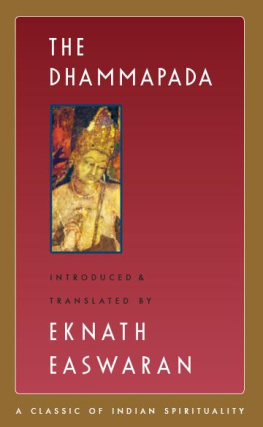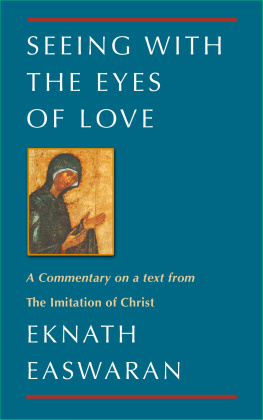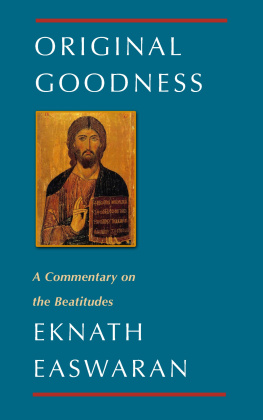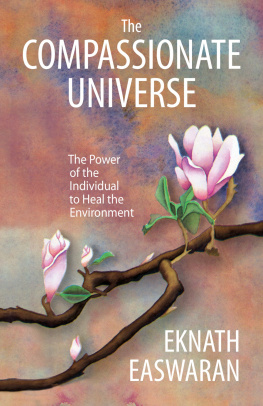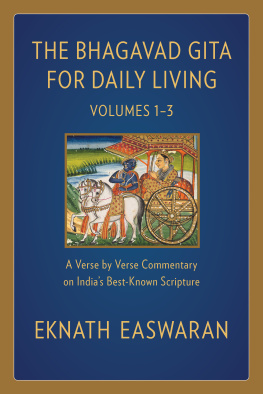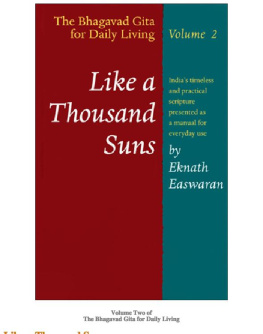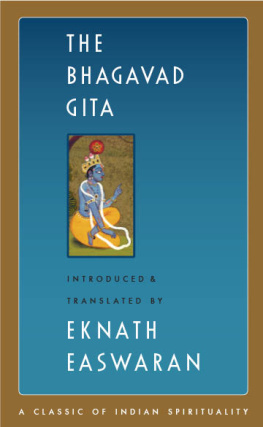Eknath Easwaran Ed. - The Dhammapada (Classics of Indian Spirituality)
Here you can read online Eknath Easwaran Ed. - The Dhammapada (Classics of Indian Spirituality) full text of the book (entire story) in english for free. Download pdf and epub, get meaning, cover and reviews about this ebook. year: 2009, publisher: Nilgiri Press, genre: Religion. Description of the work, (preface) as well as reviews are available. Best literature library LitArk.com created for fans of good reading and offers a wide selection of genres:
Romance novel
Science fiction
Adventure
Detective
Science
History
Home and family
Prose
Art
Politics
Computer
Non-fiction
Religion
Business
Children
Humor
Choose a favorite category and find really read worthwhile books. Enjoy immersion in the world of imagination, feel the emotions of the characters or learn something new for yourself, make an fascinating discovery.
- Book:The Dhammapada (Classics of Indian Spirituality)
- Author:
- Publisher:Nilgiri Press
- Genre:
- Year:2009
- Rating:5 / 5
- Favourites:Add to favourites
- Your mark:
- 100
- 1
- 2
- 3
- 4
- 5
The Dhammapada (Classics of Indian Spirituality): summary, description and annotation
We offer to read an annotation, description, summary or preface (depends on what the author of the book "The Dhammapada (Classics of Indian Spirituality)" wrote himself). If you haven't found the necessary information about the book — write in the comments, we will try to find it.
The Dhammapada (Classics of Indian Spirituality) — read online for free the complete book (whole text) full work
Below is the text of the book, divided by pages. System saving the place of the last page read, allows you to conveniently read the book "The Dhammapada (Classics of Indian Spirituality)" online for free, without having to search again every time where you left off. Put a bookmark, and you can go to the page where you finished reading at any time.
Font size:
Interval:
Bookmark:
The Dhammapada
Introduced & Translated by
E K N A T H E A S W A R A NAs irrigators guide water to their fields, as archers aim arrows, as carpenters carve wood, the wise shape their lives. [145]
 N I L G I R I P R E S S
N I L G I R I P R E S S 1985, 2007 by The Blue Mountain Center of Meditation
All rights reserved.
Second edition.
This printing restores the version of chapter 1 used in the first edition.
Print book ISBN 9781586380205
E-book ISBN 9781586380243
Library of Congress Control Number: 2006934967
20110513
Eknath Easwaran founded the Blue Mountain Center of Meditation in Berkeley, California, in 1961. The Center is a nonprofit organization chartered with carrying on Easwarans legacy and work. Nilgiri Press, a department of the Center, publishes books on how to lead a spiritual life in the home and community. The Center also teaches Easwarans program of passage meditation at retreats.
For information please visit www.easwaran.org,
call us at 800 475 2369 (US) or 707 878 2369
(international and local), or write to us at
The Blue Mountain Center of Meditation,
Box 256, Tomales, CA 949710256, USA.
Table of Contents
Foreword
Imagine a vast hall in Anglo-Saxon England, not long after the passing of King Arthur. It is the dead of winter and a fierce snowstorm rages outside, but a great fire fills the space within the hall with warmth and light. Now and then, a sparrow darts in for refuge from the weather. It appears as if from nowhere, flits about joyfully in the light, and then disappears again, and where it comes from and where it goes next in that stormy darkness, we do not know.
Our lives are like that, suggests an old story in Bedes medieval history of England. We spend our days in the familiar world of our five senses, but what lies beyond that, if anything, we have no idea. Those sparrows are hints of something more outside a vast world, perhaps, waiting to be explored. But most of us are happy to stay where we are. We may even be a bit afraid to venture into the unknown. What would be the point, we wonder. Why should we leave the world we know?
Yet there are always a few who are not content to spend their lives indoors. Simply knowing there is something unknown beyond their reach makes them acutely restless. They have to see what lies outside if only, as Mallory said of Everest, because its there.
This is true of adventurers of every kind, but especially of those who seek to explore not mountains or jungles but consciousness itself: whose real drive, we might say, is not so much to know the unknown as to know the knower. Such men and women can be found in every age and every culture. While the rest of us stay put, they quietly slip out to see what lies beyond.
Then, so far as we can tell, they disappear. We have no idea where they have gone; we cant even imagine. But every now and then, like friends who have run off to some exotic land, they send back reports: breathless messages describing fantastic adventures, rambling letters about a world beyond ordinary experience, urgent telegrams begging us to come and see. Look at this view! Isnt it breathtaking? Wish you could see this. Wish you were here.
The works in this set of translations the Upanishads, the Bhagavad Gita, and the Dhammapada are among the earliest and most universal of messages like these, sent to inform us that there is more to life than the everyday experience of our senses. The Upanishads are the oldest, so varied that we feel some unknown collectors must have tossed into a jumble all the photos, postcards, and letters from this world that they could find, without any regard for source or circumstance. Thrown together like this, they form a kind of ecstatic slide show snapshots of towering peaks of consciousness taken at various times by different observers and dispatched with just the barest kind of explanation. But those who have traveled those heights will recognize the views: Oh, yes, thats Everest from the northwest must be late spring. And here were south, in the full snows of winter.
The Dhammapada, too, is a collection traditionally, sayings of the Buddha, one of the very greatest of these explorers of consciousness. In this case the messages have been sorted, but not by a scheme that makes sense to us today. Instead of being grouped by theme or topic, they are gathered according to some dominant characteristic like a symbol or metaphor flowers, birds, a river, the sky that makes them easy to commit to memory. If the Upanishads are like slides, the Dhammapada seems more like a field guide. This is lore picked up by someone who knows every step of the way through these strange lands. He cant take us there, he explains, but he can show us the way: tell us what to look for, warn about missteps, advise us about detours, tell us what to avoid. Most important, he urges us that it is our destiny as human beings to make this journey ourselves. Everything else is secondary.
And the third of these classics, the Bhagavad Gita, gives us a map and guidebook. It gives a systematic overview of the territory, shows various approaches to the summit with their benefits and pitfalls, offers recommendations, tells us what to pack and what to leave behind. More than either of the others, it gives the sense of a personal guide. It asks and answers the questions that you or I might ask questions not about philosophy or mysticism, but about how to live effectively in a world of challenge and change. Of these three, it is the Gita that has been my own personal guidebook, just as it was Mahatma Gandhis.
These three texts are very personal records of a landscape that is both real and universal. Their voices, passionately human, speak directly to you and me. They describe the topography of consciousness itself, which belongs as much to us today as to these largely anonymous seers thousands of years ago. If the landscape seems dark in the light of sense perception, they tell us, it has an illumination of its own, and once our eyes adjust we can see in what Western mystics call this divine dark and verify their descriptions for ourselves.
And this world, they insist, is where we belong. This wider field of consciousness is our native land. We are not cabin-dwellers, born to a life cramped and confined; we are meant to explore, to seek, to push the limits of our potential as human beings. The world of the senses is just a base camp: we are meant to be as much at home in consciousness as in the world of physical reality.
This is a message that thrills men and women in every age and culture. It is for such kindred spirits that these texts were originally composed, and it is for them in our own time that I undertook these translations, in the conviction that they deserve an audience today as much as ever. If these books speak to even a handful of such readers, they will have served their purpose.
The Dhammapada
Introduction
If all of the New Testament had been lost, it has been said, and only the Sermon on the Mount had managed to survive these two thousand years of history, we would still have all that is necessary for following the teachings of Jesus the Christ. The body of Buddhist scripture is much more voluminous than the Bible, but I would not hesitate to make a similar claim: if everything else were lost, we would need nothing more than the Dhammapada to follow the way of the Buddha.
The Dhammapada has none of the stories, parables, and extended instruction that characterize the main Buddhist scriptures, the sutras. It is a collection of vivid, practical verses, gathered probably from direct disciples who wanted to preserve what they had heard from the Buddha himself. In the oral tradition of the sixth century before Christ, it must have been the equivalent of a handbook: a ready reference of the Buddhas teachings condensed in haunting poetry and arranged by theme anger, greed, fear, happiness, thought. Yet there is nothing piecemeal about this anthology. It is a single composition, harmonious and whole, which conveys the living presence of a teacher of genius.
Font size:
Interval:
Bookmark:
Similar books «The Dhammapada (Classics of Indian Spirituality)»
Look at similar books to The Dhammapada (Classics of Indian Spirituality). We have selected literature similar in name and meaning in the hope of providing readers with more options to find new, interesting, not yet read works.
Discussion, reviews of the book The Dhammapada (Classics of Indian Spirituality) and just readers' own opinions. Leave your comments, write what you think about the work, its meaning or the main characters. Specify what exactly you liked and what you didn't like, and why you think so.

